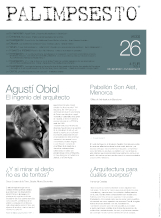TOPOLOGÍA DEL PAISAJE EN LA ARQUITECTURA DE LOS MAESTROS DE OPORTO
Las Quintas de Conceiçao y Santiago en la obra y pensamiento de Távora, Siza y Souto de Moura
DOI:
https://doi.org/10.5821/palimpsesto.26.12611Abstract
El texto es una reflexión sobre las raíces de la Escuela de Oporto a través del proyecto de un parque sorprendente: Quintas de Conceição y Santiago (F. Távora 1956-60), una pieza de sutura entre la infraestructura portuaria y la ciudad de Leça de Palmeira.
El texto, introducción de un trabajo de investigación más extenso, se conduce a través de citas de los protagonistas, nunca de opinadores sobre su obra, limpiando la mirada sobre lo que conocemos de interpretaciones muy valiosas, es verdad, pero que hemos querido mirar, y traducirlo aquí, con la mirada e interpretación seminal de sus autores sobre el cómo hacer.
En las Quintas de Távora, el inventor de la nueva arquitectura portuguesa, como dice Siza, estaban escritas las instrucciones de gran parte de los proyectos del grupo principal para los siguientes años. Távora, Siza especialmente, y Souto, el verso suelto.
Con una lectura cuidadosa del sitio, integraron lo muy pequeño con lo muy grande. Enseñaron que en la dificultad de lo urbano y la geografía imposible, sí que era posible, sin que apenas se notase, emocionar al colocar un edificio, construir su acceso sorprendiendo, encuadrar el paisaje con las ventanas más bonitas del siglo XX, sentir lo edilicio como algo dinámico, casi cinematográfico en su registro, y sobre todo con el amor por el detalle preciso, porque el rigor no era un límite para la imaginación ni para la creatividad, porque la “CALIDAD” –según Siza citando en mayúsculas al Che Guevara en aquel escrito dedicado a las brigadas técnicas del SAAL-, “ERA EL RESPETO POR EL PUEBLO”.
Downloads
Published
Issue
Section
License
PROTECTION AND INTELLECTUAL PROPERTY CRITERIA
Authors whose work is published in en Palimpsesto agree to the following terms:
1. The author retains the copyrights and guarantees the magazine the right to apply a Creative Commons Attribution-NonCommercial-NoDerivatives (CC BY-NC-ND), which permits others to share the work with acknowledgement of authorship.
2. The author may establish additional agreements of his or her own accord for non-exclusive distribution of the article published in the magazine (for example, in an institutional repository, or published in a book).
3. Electronic distribution of the work by the author(s) is permitted and encouraged (for example, in institutional repositories or on the author’s own website), prior to, and during the submission process, as this can generate productive exchanges, as well as earlier and greater citation of the published works (see The Effect of Open Access) (in English).
4. The author or provider of the material submitted for publication authorizes Palimpsesto to publish, with no obligation whatsoever (financial or otherwise) to the content of said material, be it in paper or digital format, or in any other medium.
5. The author or provider guarantees that he or she is the owner of the Intellectual Property rights to the contents provided, which encompasses the text and images/photographs/photographic works incorporated in the article.
6. The author or provider, exempts Palimpsesto magazine of all and any responsibility relating to violation of copyrights, thereby committing himself or herself to undertaking all efforts to assist Palimpsesto magazine in defence of any accusation, extra-judiciary, and/or judicial measures. Likewise, the author or provider will assume payment to Palimpsesto of any sum or compensation that must be paid to third parties for failure to comply with these obligations, be it the result of judicial, arbitrary or administrative decisions.
7. The submission of the texts by authors implies automatically a declaration of non plagiarism of its contents







